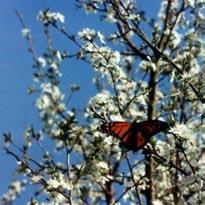
25 minute read
Common Fruits Apple Fig Nuts Peach Pear Plum
from Edible Landscape
Butterfly in the Powers’ plum tree
Common Fruit
Advertisement
Even though we have a yard and greenhouse full of exotic fruit, we also have a number of the ordinary fruit trees that you’d find in many backyards: pears, figs, lemons, plums, peaches, and apples. But there are some problems growing these common fruits here. The grocery store pears that grow well in California or Washington State do poorly here because our winters are a great deal warmer than those places. Citruses and figs that do well in California or Florida don’t necessarily do well on the Upper Gulf Coast of Texas. I’ve given advice on the varieties of these fruits you should look for so you don’t waste the next five or ten years cultivating something like the Bartlett pear, only to learn it will never ever bear fruit here.
…Produces fruit in 8 to 10 years from planting; …Produces fruit in dwarf varieties can produce in 2 to 3 years …Harvest in June and July, depending on variety
Some of the low chill apples like Anna and Golden Dorsett can be grown successfully here. There may be others low chill varieties now, but the ones I have tried have all died too soon to tell what they could do.
Rootstock Issues
All the apples I have purchased have been on Mark rootstock. Most have lasted only two or three years before they died, and the rest are trying to die. I have one Golden Dorsett on M26 rootstock in the same row and with the same care, as the 15 dead trees on Mark. It has produced a large number of apples for the neighbor’s cow and for the wildlife for each of the past eight years. I have had a hard time finding more M26 trees to experiment with.
All the old literature I have found says that M26 rootstock won’t work here. However, there is a new rootstock release due out soon that eliminates some of M26 problems. In the meantime, I am trying a few M111s which is only about 25 percent dwarfing. Three of the four trees I purchased are still alive and seem healthy, but are not growing well. If I can find a dwarfing rootstock that will grow in gumbo, I could use it to grow apples. With an inter-stem, I could also dwarf pear trees to take up less space and start producing earlier.
What To Do
If you have gumbo soil and really want to grow apples, I suggest a raised bed with good soil and a more dwarfing rootstock than Mark. Trees on dwarfing rootstock, that grow from 5 to 10 feet tall, will need to be supported throughout their lifetime. The support can be provided by a steel post or by guy wires like a radio tower. You can also espalier apple trees on wire or against a fence to take up less space. As long as you only have two or three trees, spray with dormant oil in the winter, and keep the leaves raked up and disposed of.
If you don’t mind a blemish or two on the fruit, you should be able to grow apples with very little or no spraying with an insecticide or fungicide.
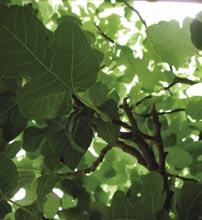
…Produces fruit in 1 to 2 years from planting …Harvest from mid June to mid August at daybreak, before the birds wake up
We have several varieties of figs. About half of them are unknown varieties. We pick and eat a few as we walk by the trees and the birds eat the rest. They are very easy to grow.
Figs need a lot of water and should be mulched heavily to preserve moisture during droughts. Nematodes can be a serious problem if you have light sandy soil, since figs are their favorite food. I read an article by a man that had trouble growing figs because of nematodes. Nematodes only live in the top two or three inches of soil, so he dug a hole the depth of the pot the tree was in, then he cut the bottom and a few inches of the side off the pot. He planted the fig tree in the hole, leaving the top eight inches of the pot intact, thus protecting the tree from the surrounding soil. The fig trees were still doing fine after four or five years.
Another option would be to plant an LSU Purple, a variety of fig which is nematode resistant. One can then graft or bud desirable varieties onto the LSU Purple rootstock.
Figs can easily be propagated by cutting of a branch, dipping the cut-end in some rooting powder, and sticking it in the ground or in a pot. It will need to be well watered until it becomes established.
Fig Varieties
Figs come in both closed-eye and open-eyed varieties — meaning the little opening in the bottom of the fig fruit either opens like a flower or stays closed with a drop of nectar. I would recommend that you plant a variety with a closed eye. Otherwise the fruit beetle or rain can get in eye and sour the fruit.
The Blackjack fig tree is very unusual. Instead of bushing out from the bottom up like most fig trees, it shot straight up 10 feet high, established its vegetation at the top like a palm tree, and then sent out straight branches from the top down. The tree produces a good yield of medium large, closed-eye, dark brown figs. The inside of the figs are honey-colored and taste very good.
The old Celeste or “Sugar Fig” is the variety favored by most gardeners in our region. It produces abundant small tan or brown figs, are very sweet, and closed eye. The trees themselves are bushy, carefree, and bug resistant. The skins on the Celeste figs are very thin, easily damaged, and the fig itself is highly perishable. If we get a torrential rain, these figs will get waterlogged and will sour on the tree. But they are very productive, delicious tasting, and good for both eating and cooking.
The Green Ischia we have has pretty good taste and is medium-sized, but it is not extremely productive. It has a slightly pale green color and a bright red interior. When this green fruit ripens and gets softer to the touch, the birds supposedly won’t bother the fruit. But we have more intelligent birds than most people or our birds have better color perception, because they do a good job of finding the ripe fruit and consuming it.
The LSU Purple produces medium-sized dark purple figs over an extended period of time. But the taste varies from good to tasteless. LSU Purples will produce sweeter figs in cooler wetter years. In dry hot years, which we have quite often, these figs are not as sweet and tasty.
We have a Texas Everbearing but is likely something else — maybe a Brown Turkey. It is large dark fig and with a slightly open eye. It very seldom ripens enough fruit at one time to make preserves, but produces enough fruit to eat a couple of fresh figs each day from the middle of summer until frost.
Some nurseries sold Celestes as Texas Everbearing also, so there’s some confusion about the names of some figs, even in the horticulture literature.

A bowl of fresh figs
Our Favorites
Everyone has a favorite fig. Ginger likes the flavor of the Blackjack best, and we both like LSU Purple when it’s moist. Texas Everbearing is also good.
Most people in the region favor the Celeste “Sugar” fig for its very sweet flavor, versatility in cooking, and high productivity. Our Master Gardener friends have grown Banana figs — an excellent and delicious fig discovered many years ago by Mr. Hester, an old nurseryman in Seabrook. It is a large golden-colored fig with a delicious flavor. Another fig quite similar to it is the Alma fig, a large, tan-colored fig developed by Texas A&M, that has a honey flavor. Kadota, a California staple, is a green fig with a tan interior, and does okay here, though it’s better for cooking than eating. Dr. Bill Welch, a great horticulture professor at Texas A&M, favors a rare variety called the South Carolina Lemon fig. When it ripens, it is the color and size of a small Eureka lemon, and has a delicious, sweet/spicy flavor. But I don’t have one of these.
Ginger finds that all the figs make attractive tan-colored preserves except LSU Purple and Blackjack, which turn unattractively black.

Young pecan tree

Sam prepares pecan graft wood …Nut tree produces nuts 15 to 20 years from planting …Harvest in the fall, after the first norther comes through, from October through November
Nuts are a lot of trouble to grow in our region due to various diseases and insects that can attack the trees or the nuts. The great insect problem is the leaf-footed stink bug, which ruins the nuts and makes them very bitter.
Our experience with nut trees has not been happy.
ALMONDS: We’ve killed a couple. They’re like apricot trees. They need care, might produce a nut or two, but really don’t want to live here.
HEART-NUTS: These are good-tasting nuts, and grew remarkably well for awhile. I found out why when I fixed a leak in a nearby pipe. The trees had an abundant supply of water, but died immediately when I fixed the leak. PECANS: I have three or four pecan trees. They grow fast, take up a lot of space, make great shade trees, but they’re hard work. They have to be sprayed with zinc and other products occasionally, have to be carefully and frequently fertilized, and sometimes have to be watered — in essence, they are not carefree trees.
However, the people we know who pamper their pecan trees get very good harvests of good quality pecans. Galveston County hosts a pecan show every year in November or December at the Walter Hall Pavilion in League City, Texas. Attending this show is a good way to familiarize yourself with the varieties that grow best in the area, and talk to the prize winners who know a great deal about cultivating them.
WALNUTS: We grew both large and small black walnuts. After 10 to 15 years, they only produced a few nuts a year. They weren’t worth the bother.
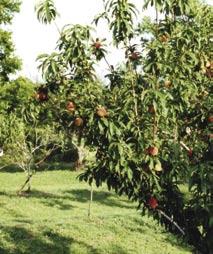
…Produces fruit 3 to 5 years after planting …Harvest fruit from mid-May to mid-July depending on the variety and the weather
We grew some delicious peaches for a few years. We planted the trees on high rows, and did the best to provide them with good drainage. However, the land itself didn’t drain well. In the winter, we had standing water in the ditches between the trees during some wet years. When the trees were small and didn’t have deep root systems, they were okay. But when the trees got big and their root systems went deeper than the ditches between the rows, the trees drowned in the standing water. Our nearby peach-grower friend grew wonderful peaches for decades because his property backed up to a large county drainage ditch. He never had standing water even in the ditches between his trees.
How I Planted Peaches
I had put peaches on large raised mounded rows, 16 feet wide from the low point on one side to the low point on the other side. I used 20 Nemagard seedlings for rootstock, the recommended nematode-resistant rootstock used by professional peach orchardists. Arnold Lippert, a friend and fellow peach grower, brought me an assortment of scion wood for the grafting of peaches, plums, and nectarines. The rows were 150 feet long. I grafted the seedlings and set them in the rows 15 feet apart. This filled up two rows.
Not Carefree Trees
All the trees survived the summer, then I realized I had a big problem. I needed to irrigation the trees. I rented a ditching machine, bought 700 feet of 1 ½ inch PVC pipe, 300 feet of 1 inch PVC pipe, fittings and valves for both pipes sizes, a 3 inch diameter shallow well, and a high volume 1 HP pump. All of this was bought on my $100 a month allowance. A man that I had worked with called and offered me a part-time short-term job. So, I worked a couple weeks, but when he left, I quit. By this time, I had enough mad money to put in my irrigation system and stay within my budget.
I wrote Dr. Sherman at the University of Florida an inquiry about the Okinawa hybrid and Florida Guard rootstock that I had heard about. He set me about 250 seeds from each tree. I gave away all I could but still had way too many seeds left. I cracked the shells and remove the seeds, then placed them in a plastic sealing bag with sterile moist sand. I stratified them in the refrigerator for a month, and took them out and planted them in pots. When they got large enough I planted them in the orchard and grafted them as I acquired scion wood of something I didn’t have.
I also bought a few peach trees from TreeSearch Farms — some from Tennessee and a few from Florida.
I was running out of room so I planted trees in between the original ones planted plus two more rows with a 7½ foot spacing. I also planted a number of them around the house.
We had a very wet winter where the rainwater stood in the bottom of the rows for a couple months when the trees were two and three years old. It didn’t bother the trees in the least and I thought I had it made. One year, I sprayed Imidine, a low environmental impact spray, for plum curculio, but that became too much of a hassle. Then a few years ago, I ran across a number of articles where some of the English cattlemen were linking continued use of Imidine on cattle to mad cow disease. Scary.
When the trees got to be five years old, they had a nice size and were getting ready to come into production. Then we had another long wet winter. I wasn’t too worried. After all, they had survived a long wet winter three years earlier. What I didn’t take into account was that the trees were a lot larger, and the roots extend farther away from the trunk of the tree on the mounded high ground. The water never got within four feet of the trunk of a tree, but 75 percent of the feeder roots were underwater for weeks — and drowned. I had planted both low chill hour trees (those that require temperatures between 320 and 450 Fahrenheit to produce fruit — approximately 300 hours at those temperatures on the Upper Gulf Coast of Texas) and high chill hour trees (those that require 450 chill hours or more). The low chill trees bloomed out fine and started putting on leaves — then they started dying. Within two weeks, everything above two feet from the ground was dead. The higher chill hour trees tried to put on a couple leaves, and then just dropped dead. We had about a half a dozen trees with one or two limbs still standing on the high end off the property.
The experience was a little upsetting, but I learned that peaches did not fit my criteria of easy care and no spraying of a pesticides.
Varieties
My favorite yellow peach is Florida King. It is a large peach, on a very productive tree. It’s best if you wait until it’s slightly soft before it is picked. It doesn’t matter how red the peach is, and the color can be misleading. If you pick a reddish peach one day before it starts to soften, it will taste like cardboard. My favorite white peach was FloridaGlo. Its taste is equal to Tropic Snow, a delicious and popular variety grown locally. FloridaGlo is a larger peach than Tropic Snow, and a more productive tree for me.
We emphasize that low chill hour peaches like Tropic Snow and TexStar do well in our region, provided they have excellent drainage and are meticulously pruned, sprayed several times, and the fruit thinned when it becomes crowded on the branch.
They take a great deal of care, but many people think they are really worth it.
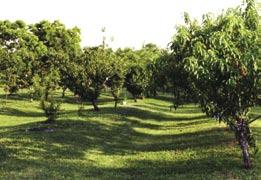
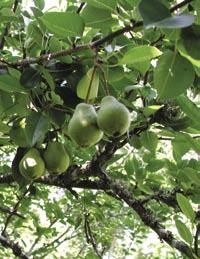
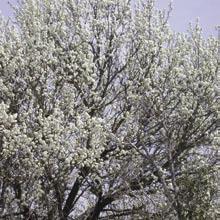
…Produces fruit 8 to 10 years after planting …Harvest fruit from mid-July to mid-September, depending on variety and weather
There are two limiting factors to growing a variety of pear trees on the Upper Gulf Coast of Texas. The first is lack of the necessary high number of chill hours required by many varieties of pear tree — which is almost impossible to overcome. We might get a very rare chilly winter, where temperatures hover between 320 and 450 Fahrenheit — but that’s a once every 20 year event.
I read that some farmers in Taiwan purchase scion wood with bloom buds already formed from a colder region, and grafted them onto these their lower chill hour trees (20,000 grafts per acre) thus overcoming the chill factor problem. But most people won’t go to those extremes. It’s just easier to buy a low chill hour pear nowadays — and there are many good ones for our region.
Fireblight
The next limiting factor to growing pears is a disease called fireblight. The pear leaves and stems of the affected area looked like they have been in a flash fire — they turn black suddenly and the upright stems curl over like a shepherd’s hook. You can spray the tree with special antibiotics such as streptomycin while the tree is in bloom. But this is just a stop gap measure, in my opinion. Almost all pear trees will develop fireblight, which is a bacterial infection carried by wind and birds. And it’s helpful to know if your tree has any resistance to fireblight. There is a wide range of resistance among the pear varieties — from highly susceptible to almost impervious.
Fireblight usually starts on twigs and very small branches. If not stopped immediately by pruning out the infected wood, the blight will proceed up the limb to the trunk and will eventually kill the tree.
The infected branch or limb should be cut off 8 to 10 inches below the infection — in healthy wood — and the shears or tools you use should be disinfected with alcohol after each cut.
Some trees have an inherent resistance, and the blight will stop before it goes into a limb or branch.
Resistant Varieties & Non-resistant Ones
There are three distinct types of pears: the European soft dessert pear, the oriental crisp and juicy pear, and hybrid crosses between the two.
Most European pears are extremely susceptible to fireblight. The oriental pears vary from highly susceptible to highly
resistant. The hybrids vary from slightly resistant to highly resistant. The amount of fireblight seen will vary from one year to the next too, depending on weather conditions. The ideal weather for fireblight’s growth is a chilly, wet, humid spring.
You probably won’t see fireblight on a tree until it starts blooming. If you have time in the spring to check the tree at least every other day, you might consider leaving the fireblight alone on a single limb on a young tree to see how far and fast it will travel. This will give you an idea of how close you have to watch that tree for fireblight in the coming years. The twigs on some pear trees — like Keiffer, Pineapple, Fanstill — will die back to the branch, and then the fireblight will stop. On other trees, the fireblight will enter the branch, and you can see it moving down the branch from one day to the next. Cut off the infected branch as instructed above before it can do any serious damage on such a susceptible tree.
If you decide to grow the susceptible to moderately susceptible varieties of pears, I suggest you acquire some Pyrus calleryana (calleryana) rootstock and graft individually limbs 8 to 10 inches from the trunk. Calleryana is extremely resistant to fireblight. So if for some reason you fail to cut out the infected branch or limb, the fireblight should stop when it reaches the calleryana. You will lose one branch and not the whole tree.
The fireblight bacteria can enter the tree through damage spots in the bark as well as through the tender blooms. When you do your annual pruning in the winter, cut out all crossing or rubbing limbs which will injure the bark.
Also avoid feeding high nitrogen fertilizer that will cause a flush of tender susceptible growth.
To reduce the time it takes to bring the tree into production and increase yield, you should use spreaders (a small board wedged in between the trunk and a limb), weights, stakes, or rope to train the upright growing limbs to a 450 angle. Be careful not to damage the bark on fireblight susceptible trees.
Chill Hour Issues
Beside their susceptibility to fireblight, most European dessert pears — like Bartlett, Bosc, and Comice — have high chill requirements, too high to be grown along the Upper Gulf Coast of Texas. That leaves you with the oriental and the hybrids varieties.

Fireblight on pear
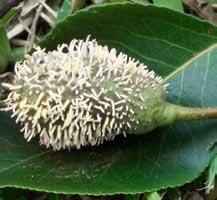
Cedar rust on pear
Because of the wide variation in pear taste and texture, and a wide variation between personal preferences, I suggest you try tasting various southern pears if possible, especially if you have limited space, before you purchased a pear tree.
The Gulf Coast Fruit and Nut Study Group in our region held an annual a pear and jujube tasting seminar in the late summer to early fall, so the public could become familiar with the various varieties. There were usually 40 or more varieties of pears grown in this area to taste. The Galveston County Agricultural Extension Office kept the results of these tastings, just to keep track of public preferences.
The hybrid pears vary from extremely hard with a large number of grit cells (Keiffer) to a very soft pear without grit cells (Warren). The Warren often wins our taste tests, but is slow to start bearing — 10 to 12 years — and produces very few fruit when it does start bearing. It has about a 400 to 500 chill hour requirement, too high for most of our mild winters. However, I have read a couple accounts from commercial orchard owners saying they were harvesting bumper crops from their Warren pears. They had both planted a row of pear trees that bloomed at the same time as the Warren pear next to the Warren pears. Since they never saw any bees pollinating the Warren pears, their theory was that the prevailing wind blew the pollen onto the Warren trees. If you just have to grow a Warren pear you might try grafting a limb from a different variety on the up wind side of the tree.
The most consistent and heaviest producing pear we have is the Pineapple pear. It is a firm pear, does have some grit cells, and does not keep well in the refrigerator — only about six weeks at the most. However, it is very good for cooking and can be eaten fresh. We have several other hybrid varieties that have fruited, and several more than have not yet produced fruit. The ones that have fruited are Fanstill, Atlas Super Orient, Spaulding, Biscamp, Southern Bartlett, Tennessee, Keiffer, and Warren (only four pears).
One year, the Spaulding did have a large crop, but the critters ate nearly all of them. The Fanstill, Biscamp, and Southern Bartlett are all three softer than the Pineapple and have fewer grit cells. But they seemed to need a few more chill hours than we’ve received in the last few years to produce a good crop.
The Fanstill leafed out the first part of February one year without any blooms. The last week in February, we had a week of cold weather and the temperature remained between 38 and 500 Fahrenheit for five or six days. The Fanstill lost its leaves and then put on a few blooms before it leafed out again.
After the cold spell, the Asian pears — Hosui, 20th century, and Ya Li — each put on a couple of blooms and set two or three pears. None of the three trees received enough chill hours for the leaves to break dormancy. The leaves manufacture food for the tree. But after a couple years without leaves, the tree will use up its reserve energy and die.
Favorite Varieties
My personal favorite is the Ya Li. It has a sweet mild flavor, and crisp juicy texture. The fruit will store in the refrigerator for six months without any special treatment, and will taste as good as it did fresh from the tree. Ginger likes the Pineapple pear, for its slight fragrance of pineapple along with its excellent cooking qualities. The Hosui is another large, juicy, sweet, bronze-colored Asian pear that will keep about four months in the refrigerator. I have several other Asian pear varieties that have not fruited because of their youthful age and or lack of chill hours in the last couple of years.
Other pears that have done well in our taste tests include the Asian pear Shinseiki and Hosui, and the hybrids called Orient (which enjoys exceptional fireblight resistance) and Tennessee.
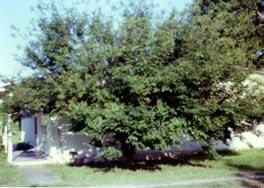
…Produces fruit about 5 years after planting …Harvest fruit from May to July, depending on variety and weather
Plums are much heartier and easier to grow than peaches. One has to be careful to get a plum variety that has low chill hours — most of the California varieties are far too high for our region. Furthermore, plums have to be sprayed for borers and the plum curculio, which will certainly destroy the trees if they’re left untended.
Plums and Me
We had been living here for about three years when my brother drove in from Oyster Creek. He had seen an advertisement for plum trees for five dollars each. I gave him $10, and after a couple hours he showed up with two plum trees without any name tags. Twenty-five years later, I learned the trees had names other than peach, plum, pear, pecan, and so forth.
We planted one of the little things about ten feet from the house and six feet from the front walk. The little thing sat there surviving for about ten years before it decided to grow. A friend gave us a couple of wild plums, and we bought two more. We set out all four in front of the house.
We were wandering around on the outer fringes of a nursery one day when we spotted a plum tree in a pot that was full of fire ants. The manager walked up and said we could have it if we would get that thing out of there. We loaded it in the back of the pickup and came home.
The Powers Plum
We have never been able to identify the plum tree that my brother brought us. In the spring we would pick a couple dozen plums and take off on the back roads looking for old nurseries or orchards. We found a surprisingly large number of these old nurseries. Nearly everyone took one look at the fruit and said it was Methley. After they took a bite they all said it was too sweet to be a Methley. Several of the men that were still in business wanted some trees to sell. A man in Alvin said he had tasted one like that when he was a kid. He said a man out west of Alvin was hybridizing plums, and he had a plum that tasted like mine. An elderly man in Friendswood said when he was a kid he had ate some that grew wild on a creek bank that tasted like mine.
So one year, we saved the seeds from this plum tree. I gave my friend 150 and I kept 150. I had one germinate and he didn’t have any germinate.
Since we couldn’t identify the plum we called it the Powers Plum. It tasted wonderful, like a Bing Cherry. Besides having the best tasting plum I had ever eaten, I thought we had a plum curculio resistant variety. We wouldn’t see a half dozen bad plums in the whole crop — and we picked bushels of plums from that tree. We weren’t getting a half dozen good plums from the other five trees. I cut them all down to put in raised beds for roses and a couple peach trees.
The next year, we didn’t get over a half dozen good plums from the Powers Plum. We were mystified. The following Christmas, our son-in-law gave me a spray rig with a 16 gallon tank and pump with a 12 VDC motor. He wanted me to spray the tree so he could have some plums.
What Happened
In 2008, the plum tree died of old age. We had grafted it on some younger nearby trees, to keep it going, though.
The “Don’t Bother” Trees: Apricots and Pluots
from Sam
These can be very problematical in our area, so plan on spending a lot of time pruning, spraying, and watering if you want any.
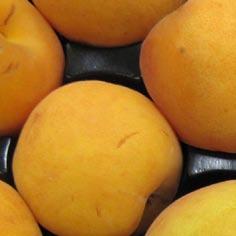
Apricots
• Don’t bother.
• They don’t want to live here.
• We’ve heard anecdotal stories about people growing apricot trees successfully here, but our experience has been dismal.
• We’ll get a couple very small fruits on a tree some years, and then they’ll drop off.
Pluots
• These have chill hours too high for our region to be really successful.
• They’re grown on peach rootstock which will drown in standing water.
58







